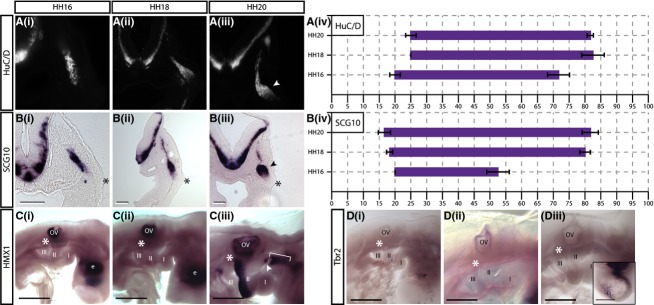Figure 6.

(A, B)SCG10 and HuC/D are expressed only in cells having reached the site of ganglion aggregation. (i–iii)In situ hybridisation showing (A)SCG10, and immunostaining showing (B) HuC/D expression in transverse sections at the level of the petrosal ganglion at (i) HH16, (ii) HH18 and (iii) HH20. Arrowheads indicate ganglionic anlage. (iv) Graphical representations of expression patterns where thex-axis = distance from placode to NT as a percentage.N = 3 for each stage. Error bars = SEM. (C, D) Lateral view ofin situ hybridisation showing (C)HMX1 and (D)Tbr2 in whole embryos at (i) HH16, (ii) HH18 and (iii) HH20.HMX1, a sensory marker in DRG, is absent from the petrosal placode and neurons (C, asterisk). It is expressed in the otic vesicle (OV) and developing eye (E) at all stages examined. At HH20,HMX1 expression is seen in the posterior aspect of the second branchial arch, and a region in the first branchial arch (bracket) that extends to the geniculate placode at HH20 (Ciii, arrowhead).Tbr2, a marker of intermediate progenitors in the cortex, is not expressed in the petrosal placode or neurons (D, asterisk).Tbr2 expression is detected in the telencephalon (inset in Diii).N = 3 for each stage. Scale bars: 500 μm.
